engine overheat GMC JIMMY 1997 Owner's Manual
[x] Cancel search | Manufacturer: GMC, Model Year: 1997, Model line: JIMMY, Model: GMC JIMMY 1997Pages: 410, PDF Size: 20.03 MB
Page 6 of 410
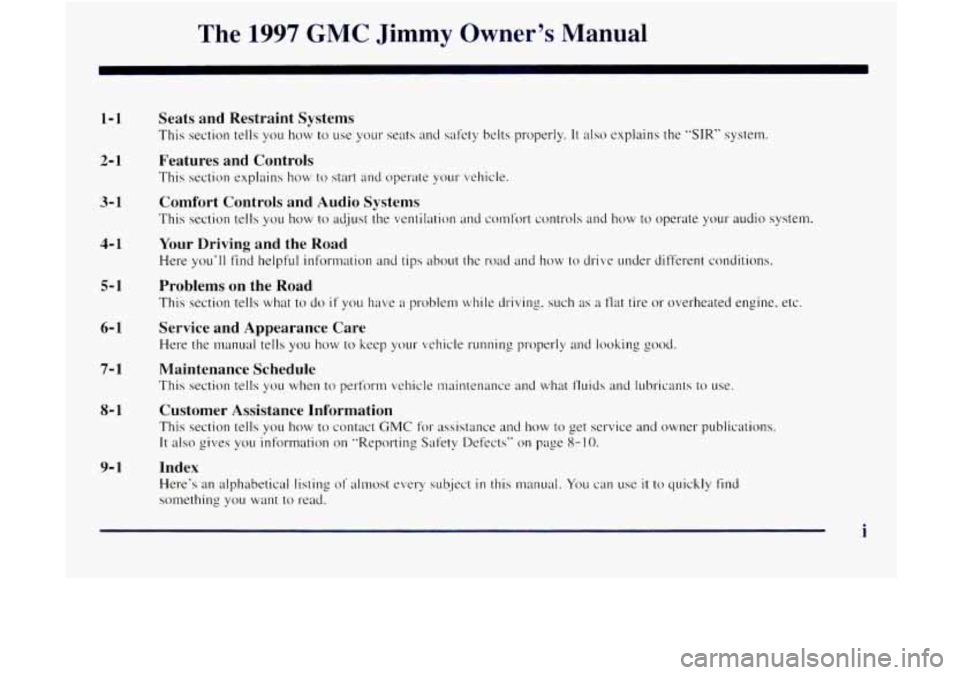
The 1997 GMC Jimmy Owner’s Manual
1-1
2- 1
3- 1
4- 1
5- 1
6- 1
7- 1
8- 1
9- 1
Seats and Restraint Systems
This section tells you how to use your seats and sal’ety belts properly. It also cxplains the “SIR” system.
Features and Controls
This section explains how to start and operate your vehicle.
Comfort Controls and Audio Systems
This section tells you how to adjust the ventilation and comfort controls and how to operate your audio system.
Your Driving and the Road
Here you‘ll find helpful information and tips about the road and how to drive under different conditions.
Problems on the Road
This section tells what to do if you have a problem while driving, such as a flat tire or overheated engine. etc
Service and Appearance Care
Here the manual tells you how to keep your vehicle running properly and looking good.
Maintenance Schedule
This section tells you when to perform vehicle maintenance and what fluids and lubricants to use.
Customer Assistance Information
This section tells you llow to contact GMC for assistance and how to get service and owner publications.
It also gives you information on ”Reporling Safety Defects” on pase X- IO.
i
Page 78 of 410
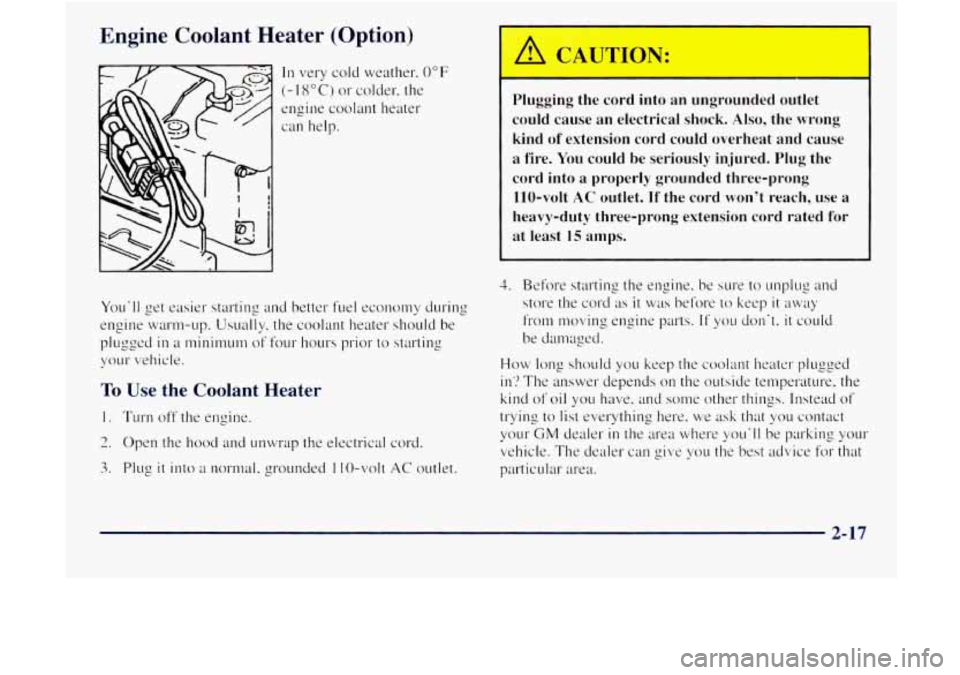
Engine Coolant Heater (Option)
In very cold weather. 0°F
(- 18°C) or colcfer. the
engine coolant heater
can help. Plugging the cord into an ungrounded outlet
could cause an electrical shock. Also, the wrong
kind
of extension cord could overheat and cause
a fire. You could be seriously injured. Plug the
cord into
a properly grounded three-prong
110-volt
AC outlet. If the cord won't reach, use
heavy-duty three-prong extension cord rated for
at least
15 amps.
You'll get easier starting and better file1 economy during
engine wa1-tm-up. Usually, the coolant heater should be
plugged
in a tnini~num of four hours prior to starting
your vehicle.
To Use the Coolant Heater
1. Turn off the engine.
2. Open the hood and unwrap the electrical cord.
3. Pl~lg it into a nol-r.nal, grounded 1 IO-volt AC outlet.
4. Before starting the engine. be s~11-e to unplug and
store the cord as it was before to keep it away
from moving engine parts. If you clon't. it could
be da111~1ged.
How long should you keep the coolant heater plugged
in? The answer depends on the outside temperature. the
kind
of oil you have, and solne other things. Instead of
trying to list everything here. we ask that ~OLI contact
yoc~r
GM dealer in the area where you'll be parking your
vehicle. The dealer can gi\:e you the best advice for that
particular area.
2-17
Page 93 of 410

Leaving Your Vehicle With the Engine
Running (Automatic Transmission
Models Only)
It can be dangerous to leave your vehicle with the
engine running. Your vehicle could move suddenlJ
if the shift lever
is not fully in PARK (P) with the
parking brake firmly set. If you have four-wheel
drive with
a manual transfer case shift lever and
your transfer case
is in NEUTRAL (N), your
vehicle will
be free to roll, even if your shift lever
is in
PARK (P). So be sure the transfer case is in a
drive gear
-- not in NEUTRAL (N). And, if you
leave the vehicle with the engine running, it could
overheat and even catch fire. You or others could
be injured. Don't leave
your vehicle with the
engine running unless you have to.
If you have to leave your vehicle with the engine
running, be sure your vehicle
is in PARK (P) and yo~~r parking brake
is firmly set before you leave
it. After
you've moved the shift lever into the PARK
(P)
position, hold the regular brake pedal down. Then, see
if you can move the shift lever away from PARK (P)
without first pulling it toward you (or pressing the
button on
a console shift lever). If YOLI can, it means that
the shift lever wasn't fully locked
into PARK (P).
Torque Lock (Automatic Transmission)
If you are parking on a hill and you don't shift your
transmission into PARK
(P) properly, the weight of the
vehicle may put too much force
on the parking pawl in the
transmission. You may find it difficult to pull the shift
lever out
of PARK (P). This is called "torque lock." To
prevent torque lock, set the parking br'ke and then shift
into PARK
(P) properly before you leave the driver's seat.
To find out how, see "Shifting Into PARK (P)" in
the Index.
When
you are ready to drive, move the shift lever out of
PARK (P) kc$~w you release the parking brake.
IF torque lock does occur. you may need to have another
vehicle push yours
a little uphill to take some of the
pressure from
the parking pawl in the transmission, so
~OLI can pull the shift lever out of PARK (P).
2-32
Page 217 of 410
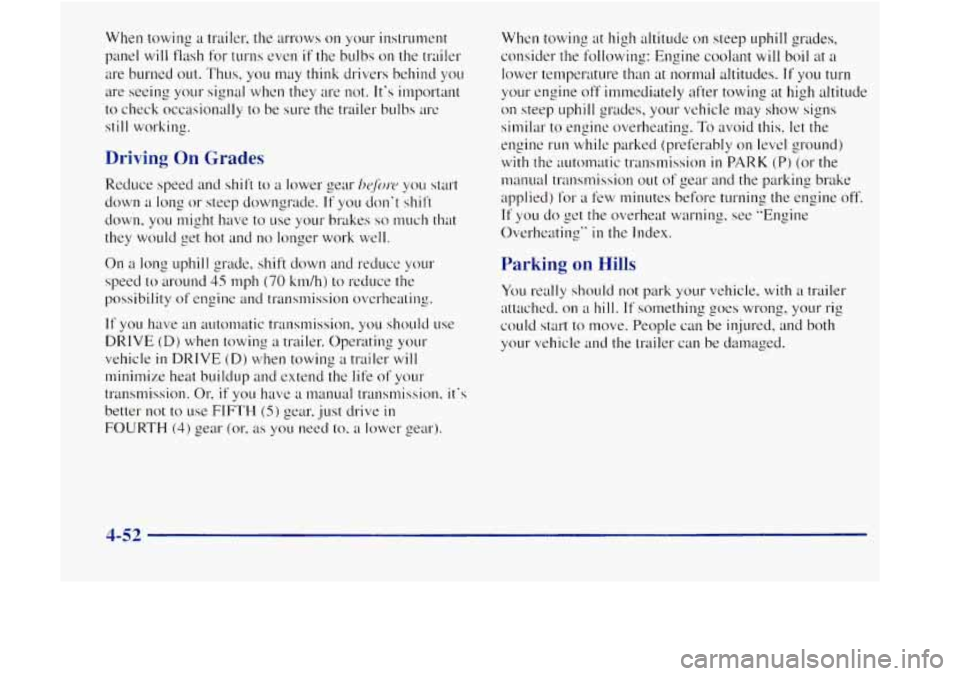
When towing a trailer, the ~~rrows on your instrument
panel
will flash for turns even if the bulbs on the trailer
itre burned out. Thus. you may think drivers behind you
are seeing your signal when they are not. It's important
to check occasionally to be sure the trailer bulbs arc
still working.
Driving On Grades
On a long uphill grade, shift down and reducc your
speed
to around 45 mph (70 km/h) to reduce the
possibility
of engine and transmission ovc.rheating.
If you have an automatic transmission. you should use
DRIVE
(D) when towing a trailer. Operating your
vehicle
in DRIVE (D) when towing a trailer will
minimize heat buildup and extend the life
of your
trrmsmission. Or:
if you have ;1 manual transmission. it's
better not to use FIFTH (5) gear. just drive in
FOURTH (4) gear (or, as you need to, a I~MW gear). Whcn
towins at high altitude
on steep uphill grades,
consider the following: Engine coolant will boil at a
lower temperature than at normal altitudes. If yo^^ turn
your engine off immediately after towing
at high altitude
on steep uphill grades, your \:ellicle may show signs
similar to engine overheating.
To avoid this. let the
engine
r~~n while parked (preferably on level grout1d)
with the automatic transmission in PARK (Pj (or the
1manuaI transmission out of
gear and the parking brake
applied) 1'01-
;I few minutes before turning the engine off.
If you do get the overheat warning. see "Engine
Overheating"
in the Index.
Parking on Hills
You really should not park your vehicle. with a trailer
attached.
on a hill. If something goes wrong, your rig
could start
to move. People can be injured, and both
yo~~r vehicle and the trailer can
be damaged.
4-52
Page 233 of 410
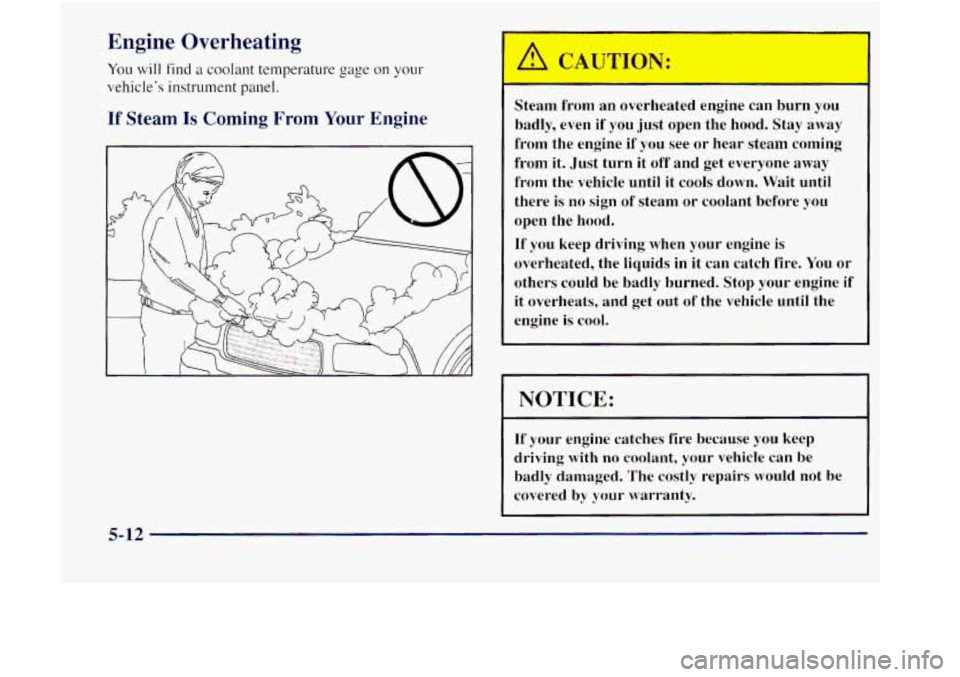
Engine Overheating
You will find a coolant temperature gage on your
vehicle's instrument panel.
If Steam Is C . - g I; - ___I Your Engine
Steam from an overheated engine can burn you
badly, even if you just open the hood. Stay away
from the engine
if you see or hear steam coming
from it. Just turn it off and get everyone
away
from the vehicle until it cools down. Wait until
there
is no sign of steam or coolant before you
open the hood.
If you keep driving when your engine is
overheated, the liquids in it can catch fire,
You or
others could be badly burned.
Stop your engine if
it overheats, and get out of the vehicle until the
engine
is cool.
NOTICE:
If your engine catches fire because you keep
driving with no coolant, your vehicle can
be
badly damaged. The costly repairs would not be
covered by your warranty.
5-12
Page 234 of 410

If No Steam Is Coming From Your Engine
If you zet the overheat warning but see or hear no
steam. the problem may not be too serious. Sometimes
the engine can get
a little too hot when you:
0 Climb a long hill on a hot day.
Stop after high-speed driving.
Idle for long periods in traffic.
Tow a trailer. See "Driving on Grades" in the Index.
If you get the overheat warning with no sign of steam,
try this for a minute
or so:
2. T~11-11 on yo~~r heater to full hot at the highest fan
speed and open the window as necessary.
3. If you're in a traffic jam. shift to NEUTRAL (N):
otherwise, shift to the highest gear \vhile
driving -- AUTOMATIC OVERDRIVE ((33) or
DRIVE (D) for automatic transmissions.
If you no longer have the overheat warning. you
can drive. Just
to be safe. drive slower for about
10 minutes. If the warning doesn't come back on.
you can drive norrnally.
If the warning continues. pull over, stop, and park your
vehicle right away.
If there's still no sign of steam. push the accelerator until
the engine speed is about twice as fast as normal idle
speed. Bring the engine speed back
to normal idle speed
after two or three minutes. Now see
if the warning stops.
But then, if you still have the warning, rum ogtlw
eugine
c~l got el?er;\.olw out oftlw \vl~iclc. until it
cools down.
You
may decide not to lift the hood but to get service
help right
away.
5-13
Page 237 of 410
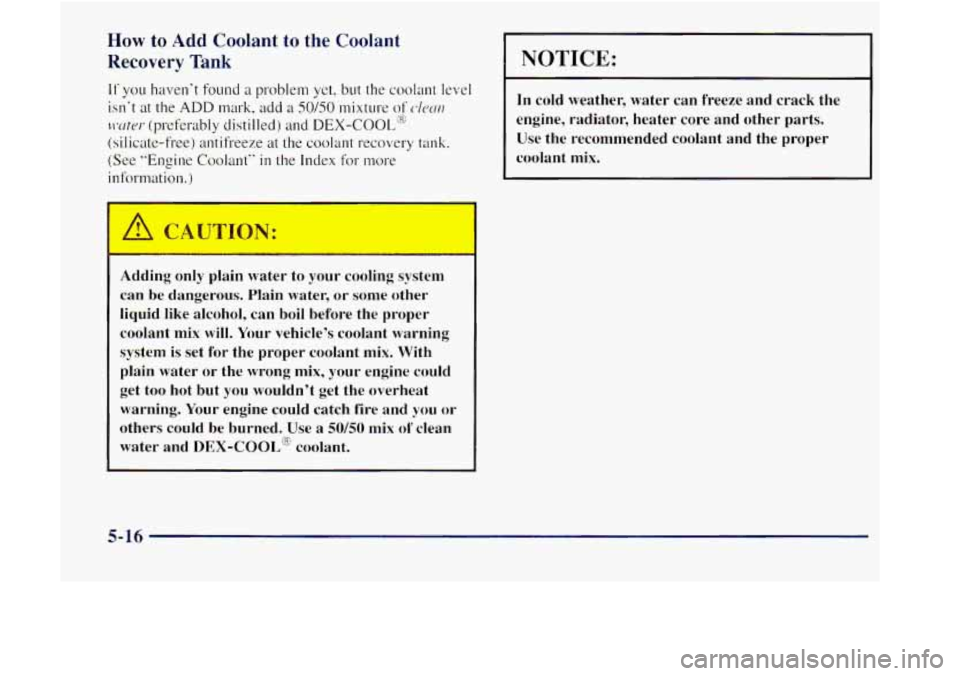
How to Add Coolant to the Coolant
Recovery Tank
If you haven't found a problem yet, but the coolant level
isn't at the
ADD mark, add a SO/SO mixture of d~ctrz
,twtur (preferably distilled) and DEX-COOL'@
(silicate-free) antifreeze at the coolant recovery tank.
(See "Engine Coolant" in the Index for more
information.
)
_s I
Adding only plain water to your cooling system
can be dangerous. Plain water, or some other
liquid like alcohol, can boil before the proper
coolant mix
will. Your vehicle's coolant warning
system is set for the proper coolant mix. With
plain water or the wrong mix, your engine could
get too hot but you wouldn't get the overheat
warning. Your engine could catch fire and you or
others could be burned. Use
a 50/50 mix of clean
water and
DEX-COOL" coolant.
NOTICE:
In cold weather, water can freeze and crack the
engine, radiator, heater core and other parts. Use the recommended coolant and the proper
coolant mix.
5-16
Page 257 of 410

~ ~~ ~~
~~~ ~~~ NOTICE:
When
the compact spare is installed, don’t take
your vehicle through an automatic car wash with
guide rails. The compact spare can get caught on
the rails. That can damage the tire and wheel,
and maybe other parts
of your vehicle.
Don’t use your compact spare on other vehicles.
And
don’t mix your compact spare tire or wheel with
other wheels or tires. They won’t fit. Keep your spare
tire and its wheel together.
NOTICE:
Tire chains won’t fit your compact spare. Using
them can damage your vehicle and can damage
the chains too. Don’t use tire chains on your
compact spare.
If You’re Stuck: In Sand, Mud,
Ice or Snow
What you don’t want to do when your vehicle is stuck is
to spin your wheels too fast. The method known as
“rocking” can help you get out when you’re stuck, but
you must use caution.
If you let your tires spin at high speed, they can
explode, and you or others could be injured. And,
the transmission or other parts
of the vehicle can
overheat. That could cause an engine
compartment fire or other damage. When you’re
stuck, spin the wheels
as little as possible. Don’t
spin the wheels above 35 mph
(55 kmh) as shown
on the speedometer.
5-36 j
Page 282 of 410
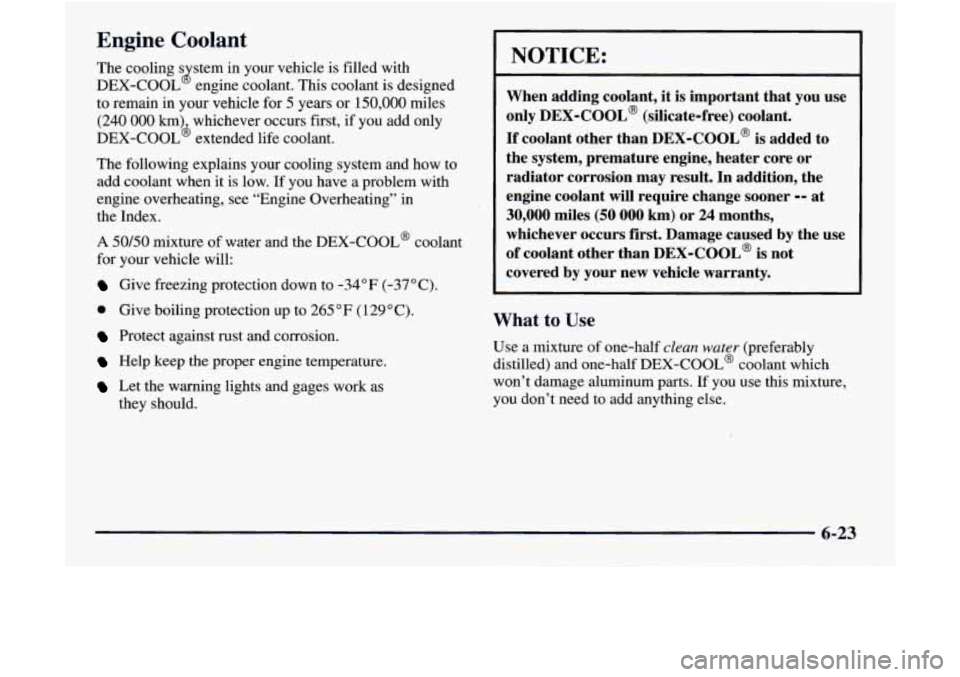
Engine Coolant
The cooling s stem in your vehicle is filled with
DEX-COOL engine coolant. This coolant is designed
to remain in your vehicle
for 5 years or 150,000 miles
(240 000 km) whichever occurs first, if you add only
DEX-COOL’ extended life coolant.
The following explains your cooling system and how to
add coolant when it is low. If you have a problem with
engine overheating, see “Engine Overheating” in
the Index.
A 50/50 mixture of water and the DEX-COOL@ coolant
for your vehicle will:
Give freezing protection down to -34°F (-37°C).
0 Give boiling protection up to 265 OF ( 129 O C).
Protect against rust and corrosion.
Help keep the proper engine temperature.
Let the warning lights and gages work as
8
they should.
NOTICE:
When .adding coolant, it is important that you use
only
DEX-COOL@ (silicate-free) coolant.
If coolant other than DEX-COOL@ is added to
the system, premature engine, heater core
or
radiator corrosion may result. In addition, the
engine coolant will require change sooner
-- at
30,000 miles (50 000 km) or 24 months,
whichever occurs
first. Damage caused by the use
of coolant other than DEX-COOL@ is not
covered by your new vehicle warranty.
What to Use
Use a mixture of one-half clean water (preferably
distilled) and one-half DEX-COOL@ coolant which
won’t damage aluminum parts. If you use this mixture,
you don’t need to add anything else.
6-23
Page 283 of 410
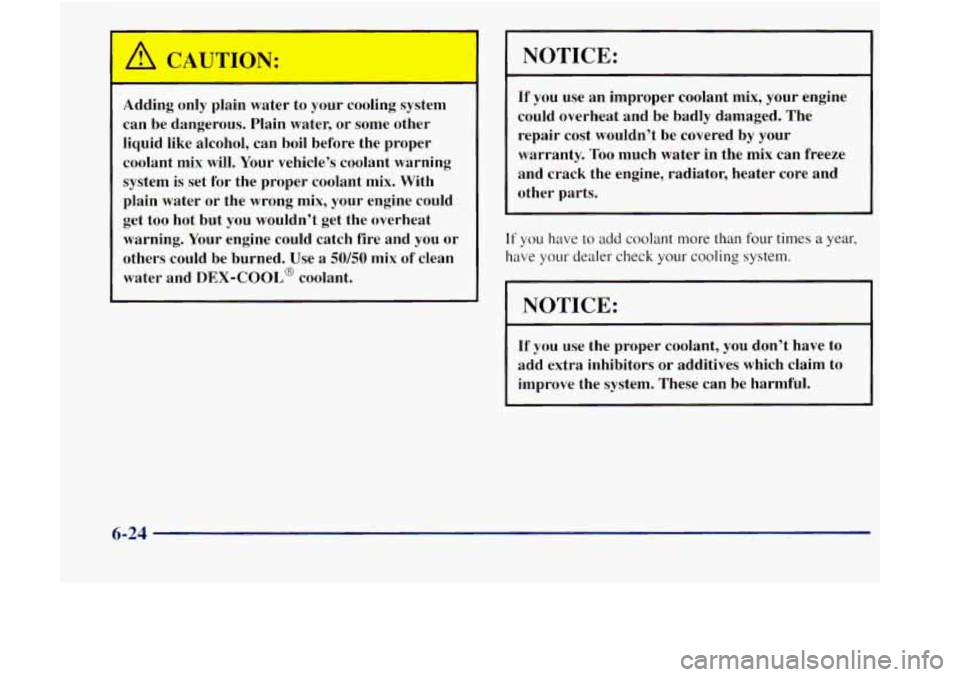
Adding only plain water to your cooling system can be dangerous. Plain water, or some other
liquid like alcohol, can boil before the proper
coolant mix will. Your vehicle’s coolant warning
system
is set for the proper coolant mix. With
plain water or the wrong mix, your engine could
get too hot but you wouldn’t get the overheat warning. Your engine could catch fire and you or
others could be burned. Use a
50/50 mix of clean
water and
DEX-COOL@ coolant.
NOTICE:
If you use an improper coolant mix, your engine
could overheat and be badly damaged. The
repair cost wouldn’t be covered by your
warranty.
Too much water in the mix can freeze
and crack the engine, radiator, heater core and
other parts.
If you have to add coolant more than four times a year,
have your dealer check your cooling
system.
I NOTICE:
If you use the proper coolant, you don’t have to
add extra inhibitors or additives which claim to improve the system. These can be harmful.
6-24